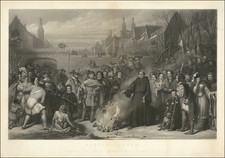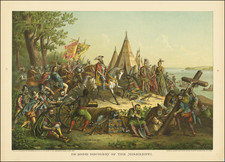Page from the Nuremberg Chronicle, telling various historical details, with illustrations of Tepestate the Astronomer and
Tepestate was a notable figure of medieval science, who was granted a perpetual stipend by Matthias, king of Nuremberg. This support allowed him to focus on his studies of topics within astronomy and other mathematical disciplines. One of Tepestate's most notable contributions to the field of astronomy was his calendar, which he composed in Bulgaria. His work was used in tandem with that of Gerard of Cremona, another significant figure in medieval science. Gerard's astronomical theories were utilized in Rome for the specific purpose of adjusting the flawed calendar of Dionysius, which again underscores the profound practical implications of astronomical work in this era.
According to the "Nuremberg Chronicle," Limpanusta emerged as a prominent figure in Franconia, in about 1376. He was critical of the clergey and emphasized the belief that theology and good teachings should remain pure and uncorrupted. He further argued that the laws should be free and accessible to all. Limpanusta claimed that he had been spoken to by the Virgin Mary. The Chronicle reports that the Bishop of Würzburg, Rudolf, captured Limpanusta and his followers, who were subjected to execution by fire in Würzburg.'
The full text translates as follows, with the bold sections relating to the engraved images:
In the Veronese territory, a monstrous creature was born that had one head, two tails, and emitted sounds from both orifices. It had two large wings with which it flew and two smaller, immobile arms. It also had two old tails connected around its stomach. Such freaks of nature were taken around Italy, where they begged for alms from the onlookers.
In the ninth month, due to heavy rains, the Tiber and other rivers overflowed, causing great damage to the local residents, to such an extent that they navigated the roads as they would riverbeds. As the waters receded, many sea creatures were pulled toward the Tiber. From their decay arose a stench which caused a great pestilence.
Spain, following the death of Henry, was divided among various people due to conflicting interests. Ferdinand, the presumptuous son of John, married the daughter of Henry and Alfonso of Portugal, thus dividing the kingdom. The following year, Ferdinand, king of Spain, defeated John in the fields of Numantia. Johannes de Monte, a German of minor nobility, was defeated in Syracuse, neither by Astronomus nor Archimedes, but was highly educated in both Greek and Latin.
Tepestate, renowned for his studies in astronomy and other mathematical disciplines, was granted a perpetual stipend by Matthias, king of Nuremberg. In Germany, he lived in luxury. He had composed an esteemed calendar in Bulgaria and other astronomical works of great effort and skill. Following the death of Astris, his greatest work, filled with his own astronomical tables, was published. Gerard of Cremona's astronomical theories were used in Rome to adjust the flawed calendar of Dionysius.
Nicolas of Cenfis quarreled with Hercules of the city. Initially, he terrified his opponents with his aggression, but after clashing with Sigismund, Hercules's brother, he was found hiding in a marsh and was captured. Not long after, the virtuous young man was executed.
Franconia, a noble German province (named after the Franks, eastern French), faced various troubles in the year of our Lord 1376. A certain Limpanusta, a heretic, began spreading his heresy. Due to his influence, many began to disdain and reject religious and clerical figures. He taught that the lives of the clergy were disgraceful and that theology and good teachings shouldn't be corrupted. He believed that the laws should be free and available to everyone. He claimed that the Virgin Mary spoke to him. While many flocked to him, he turned many against the clergy with his long sermons. Eventually, he was captured by Rudolf, the bishop of Würzburg, and the main heretics were burned at Würzburg. With his death, the pilgrimage of men and women vanished. The people of Nuremberg, however, prohibited any of their citizens from joining.
Hartmann Schedel (1440-1514) was a physician, book collector, and writer whose most famous work, the Liber Chronicarum (Nuremberg Chronicle), included some of the first printed views of many cities in Europe and across the world.
Schedel was born and died in Nuremberg, but he also traveled for his education. From 1456 to 1463 he lived in Leipzig, where he attended the University of Leipzig and earned his MA. From there he went to Padua, where he earned a Doctor of Medicine in 1466. After university, he worked for a time in Nördlingen and then returned to Nuremberg. In 1482 he was elected a member of the Great Council of Nuremberg.
The Chronicle was published in 1493. Besides this major work, one of Schedel’s most enduring legacies is his magnificent manuscript and printed book collection, one of the largest of the fifteenth century. In 1552, Schedel's grandson, Melchior Schedel, sold about 370 manuscripts and 600 printed works from Hartmann Schedel's library to Johann Jakob Fugger. Fugger later sold his library to Duke Albert V of Bavaria in 1571. This library is now mostly preserved in the Bayerische Staasbibliothek in Munich.
Among the surviving portions of Schedel's library are the records for the publication of the Chronicle, including Schedel's contract with Anton Koberger for the publication of the work and the financing of the work by Sebald Schreyer and Sebastian Kammermeister, as well as the contracts with Wohlgemut and Pleydenwurff for the original artworks and engravings. The collection also includes original manuscript copies of the work in Latin and German.









![(North Dakota) Scalp Dance of the Minatarres [near Fort Clark, on the Missouri River]](https://storage.googleapis.com/raremaps/img/small/77692.jpg)

![(Native American Portrait) Man-ce-muckt [Watercolor of Mancemuckt, Chief of the Indians of the Dalles of the Columbia River (i.e. Chief of the Skeen), after Paul Kane]](https://storage.googleapis.com/raremaps/img/small/95030.jpg)

![[King George II] George de Tweede, Koning van Groot Britannie Frankryk, Ierland enz.](https://storage.googleapis.com/raremaps/img/small/83655.jpg)
